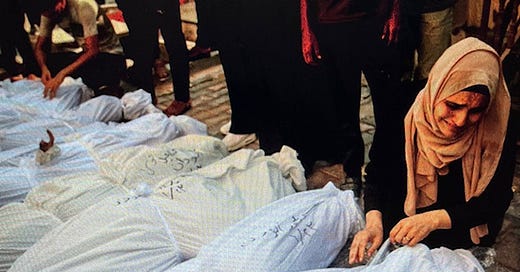One side of the story: a woman in Gaza mourns her relatives.
I’ve long defended The New York Times to friends and readers who consider the paper anti-Semitic. I still don’t think that’s true, and I appreciate the complexity and delicacy of reporting from and on the always controversial Mideast, even in relatively quiet times.
But I have become increasingly disturbed these last two months by the Times’ coverage – news content, placement, photos, Opinion pieces, etc. – that leans more toward the Palestinian narrative of victimization than to Israel’s efforts to defeat a terrorist enemy that seeks to murder Jews and destroy the state, and cynically uses its citizens as human shields.
Highlighting photos of suffering Gazans is exactly what Hamas counts on and delights in from The Times and other Western media – casting Israel as the villain.
The two most recent examples of Gaza bias were in Saturday’s edition. One was a 36-page Year in Pictures section, with the full cover (and back cover) showing a woman in Gaza weeping over a sheet covering the bodies of her siblings.
The dramatic photo conveyed half the story of this war – the devastation to Gaza – with great emotional power. But what of the other half of the story: the horrific slaughter of 1,200 Israeli men, women and children – burned, raped and ravaged – and the 240 kidnapped Israelis on Oct. 7, prompting Israel’s military campaign to defend its citizens?
The Times photos from the Israel side of events suggest an emotional distance. There was a large portrait of an Israeli family intently watching the news about their kidnapped relatives; one of two rescued hostages on a bus; and deep inside the section there are five photos related to the aftermath of the Hamas attack on Israeli kibbutzim, including the blood-stained floor of a child’s bedroom, and IDF soldiers tending to body bags on a kibbutz.
Most of the 11 additional photos related to the bombings in Gaza are more gripping, with an emphasis on young victims. And the only U.S.-based photo related to the war is of a large pro-Palestian protest in Washington, D.C. (No photos from the Nov. 14 Jewish march at the Capitol, reportedly the largest Jewish rally in American history.)
Even as I write this I feel the futility of trying to describe the underlying message conveyed by all these photos – a story of victim and victimizer, with barely any context on the horrific nature of the Hamas attack that launched Israel’s effort to end the terrorist group’s reign in Gaza.
Similarly, an Opinion piece by the mayor of Gaza City, Yahya R. Serraj, published on Saturday, described “the Israeli invasion” that he said caused “the unrelenting destruction of Gaza” with only a passing mention of the barbaric Hamas pogrom that shocked the world. For a few days.
The essay, “I Am Gaza City’s Mayor: Our Lives and Culture Are in Rubble,” includes this passage: “Why did the Israeli tanks destroy so many trees, electricity poles, cars and water mains? Why would Israel hit a U.N. school? The obliteration of our way of life in Gaza is indescribable. I still feel I am in a nightmare because I can’t imagine how any sane person could engage in such a horrific campaign of destruction and death.”
Does the mayor wonder how his countrymen could gleefully chop up, mutilate and burn women, children and the elderly, and video their attacks with pride? Does he not acknowledge that Hamas leaders and fighters position themselves in schools, mosques and apartment buildings, knowing the IDF seeks to avoid harming innocent civilians when possible?
And finally, why would the editors of the New York Times publish a piece of uncontested propaganda when their mandate is to seek and publish the truth?





Thanks very much for your thoughtful comment, Burt.
You should write this in a letter to the editor of the Times.